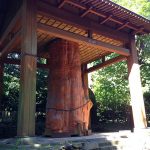SANKINKŌTAI

During Edo period (1603-1868) a system of alternate residence was established by the Shogunate to ensure a better control over the Daimyo (lords of fief). Every Daimyo was supposed to live alternatively in his fief and at the capital.
In Aso you can find vestiges of the road used by the Hosokawa clan (lords of Kumamoto) to reach the capital.
NATSUME SOSEKI IN ASO

Natsume Soseki is one of the most famous Japanese writers of the Meiji area (1868-1912). He is known all over the world for novels such as Botchan or I am a cat and you can even find his portrait on some 1000 yen bills.
One of his novels, the 210th day, tells the story of two characters climbing Mount Aso. An interesting read before any trip to Aso or to remind you of the beauty of the nature surrounding the famous volcano. Before writing this novel the author stayed in Aso and the inn he stayed at that time is still open today. You can find a room dedicated to Natsume Soseki in this traditional Japanese inn called the Sannokaku.
You may also find a commemorative plate while climbing the mountain and some words from the author in front of the Saigandenji temple.
ANCIENT TOMBS (KOFUN)

If you have an interest in ancient Japanese history you may have heard about Kofun. These ancient tombs were such an important part of that time that they gave their name to the period, the Kofun period. With the introduction of Buddhism, the use of this kind of burial progressively disappeared.
It is possible to visit the inside of the Kofun situated just next to the Kokuzô shrine. This is an occasion not to be missed as there are only a few of these tombs in Japan where you can actually go inside.
ASO SHRINE

 With a history dating back to more than 2000 years ago, Aso Shrine is the most important shrine in the area. Among the divinities enshrined here, three are believed to be the founders of Aso.
With a history dating back to more than 2000 years ago, Aso Shrine is the most important shrine in the area. Among the divinities enshrined here, three are believed to be the founders of Aso.
The Hifuri festival and the Onda festival, two very popular festivals are held here in March and July.
Unfortunately the shrine collapsed in April 2016 due to the Kumamoto earthquake. There is currently a fund-raising effort to help with the reconstruction.
 You can access Aso Shrine by car (10 minutes form Aso station) or take a bus at Aso station. It is also possible to take a train to Miyaji station and then walk for around 20 minutes.
You can access Aso Shrine by car (10 minutes form Aso station) or take a bus at Aso station. It is also possible to take a train to Miyaji station and then walk for around 20 minutes.
KOKUZŌ SHRINE

 An old shrine surrounded by nature. This shrine is also famous for a huge Japanese cedar tree that was unfortunately heavily damaged by a typhoon in 1991. Part of the trunk is still on the shrine’s ground for everyone to see.
An old shrine surrounded by nature. This shrine is also famous for a huge Japanese cedar tree that was unfortunately heavily damaged by a typhoon in 1991. Part of the trunk is still on the shrine’s ground for everyone to see.
If you like history, there is an ancient tomb (Kofun) just next to the shrine. You can even visit the inside of the tomb which is really rare in Japan.
 You can access the Kokuzō shrine by car (about 25 minutes from Aso station). It is situated north of Aso Shrine.
You can access the Kokuzō shrine by car (about 25 minutes from Aso station). It is situated north of Aso Shrine.
SAIGANDENJI TEMPLE

A Buddhist temple situated near Aso station (10 minutes on foot). There you can enjoy a festival every year where you’ll be able to walk on fire!
HIFURI FESTIVAL

Hifuri festival is maybe the most popular festival in Aso. It is held every year in March at Aso shrine. Everyone can participate by swinging flaming ropes. During the event the shrine is illuminated by circles of fire and it gives the place an even more ancient feel.
ONDA FESTIVAL


A beautiful festival held at the end of July at Kokuzō Shrine and then at Aso shrine a day after. The main attraction is the parade, especially the women dressed in white wearing the meals for the gods over their heads.
It is also a chance to assist in a religious ceremony inside the shrine, throw rice plants on portable shrines to ensure a good harvest or enjoy many kinds of food at one of the many food stalls around.
NOYAKI



Almost every year the grasslands of Aso are burnt to ensure a fresh grass for the cattle to grow and to prevent the forest from taking over. This is an important event for Aso that is made possible thanks to the work of volunteers.
Burning the grassland is not without risk and therefore Noyaki is not a tourist attraction. You may have the chance to see it from a fair distance if you visit Aso around March.







